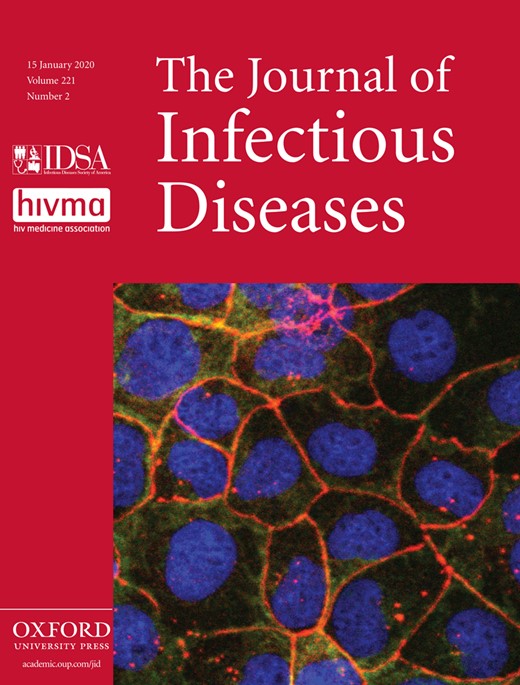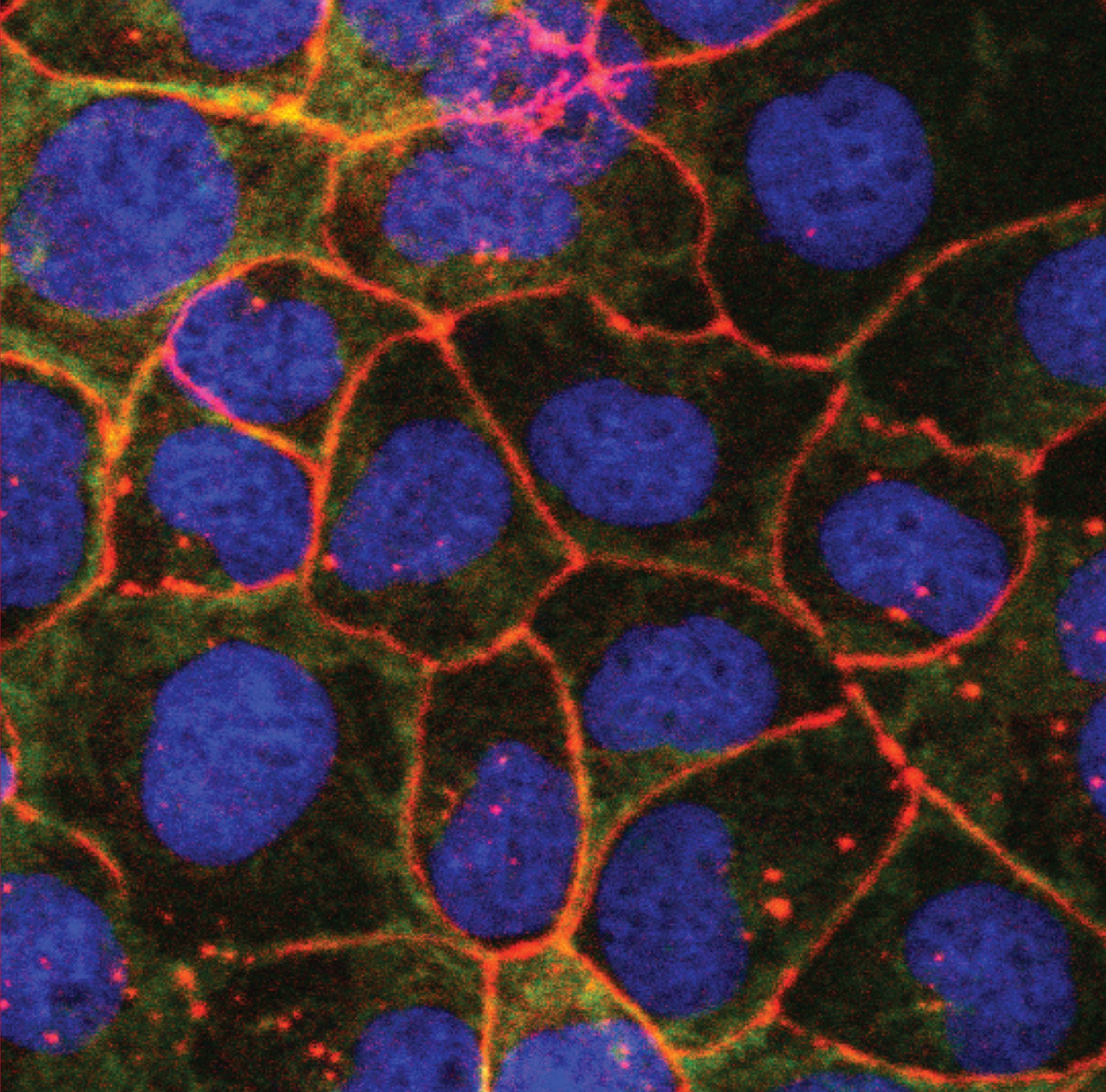
Cover image

Volume 221, Issue 2, 15 January 2020
EDITORIAL COMMENTARIES
What Are the Transmission Mechanisms of Influenza A Viruses in Wild Mammals?
Novel Approaches for Development of Human Immunodeficiency Virus Preexposure Prophylaxis Agents
MAJOR ARTICLES AND BRIEF REPORTS
VACCINES
Diet May Drive Influenza A Virus Exposure in African Mammals
Viral dynamics and ecology of influenza A viruses in nonavian wildlife are poorly characterized. Our results indicate that wild African mammals are exposed to different viral strains and that a diet including birds is a key driver of exposure.
Risk of Severe Influenza Among Adults With Chronic Medical Conditions
Population-based surveillance of acute respiratory infections among Auckland, New Zealand residents during 2012–2015 revealed significantly higher incidence and risk of influenza-related hospitalizations in adults with chronic medical conditions, with the largest effects occurring in CHF, ESRD, CAD, and COPD.
A Recombinant Chlamydia trachomatis MOMP Vaccine Elicits Cross-serogroup Protection in Mice Against Vaginal Shedding and Infertility
Female mice vaccinated with a Chlamydia trachomatis recombinant major outer membrane protein mounted robust immune responses and were cross-serogroup protected against a chlamydial genital challenge determined by rates of infection, shedding, upper genital tract pathology, and infertility.
Functional Human CD141+ Dendritic Cells in Human Immune System Mice
Our current study has demonstrated the phenotype and function of human DCs, in particular, human CD141+CD11c+ and CD1c+CD11c+ DCs, in a humanized mouse model, which may facilitate the future preclinical assessment of the immunogenicity of human vaccines in vivo.
HIV/AIDS
Correlations Between Human Immunodeficiency Virus (HIV) Infection and Rectal Gonorrhea Incidence in Men Who Have Sex With Men: Implications for Future HIV Preexposure Prophylaxis Trials
A correlation between human immunodeficiency virus (HIV) incidence and rectal gonorrhea incidence in men who have sex with men is presented; with exploration of broader implications including the construction of an index that predicts HIV incidence in preexposure prophylaxis trials.
High Rates of Hepatitis B Virus (HBV) Functional Cure Among Human Immunodeficiency Virus-HBV Coinfected Patients on Antiretroviral Therapy in Zambia
Among human immunodeficiency virus-hepatitis B virus (HIV-HBV) coinfected patients in Zambia, 10.2% experienced hepatitis B surface antigen loss within 2 years of tenofovir-containing antiretroviral therapy. Understanding the mechanisms of HBsAg loss during HIV treatment could inform HBV cure immune therapies.
Drug-Drug Interactions of Glecaprevir and Pibrentasvir Coadministered With Human Immunodeficiency Virus Antiretrovirals
Concurrent treatment of chronic HCV infection with direct-acting antiviral agents and HIV infection with antiretroviral agents in coinfected patients requires careful consideration of potential drug-drug interactions. Results and implications of clinical studies for glecaprevir/pibrentasvir with 15 antiretroviral agents are summarized.
Maternal Envelope gp41 Ectodomain-Specific Antibodies Are Associated With Increased Mother-to-Child Transmission of Human Immunodeficiency Virus-1
In a cohort of breastfeeding mother-infant pairs, plasma antibody binding to the gp41 ectodomain was associated with increased odds of transmission. Whether gp41 ectodomain-specific antibodies are directly risk-enhancing or driving immune responses away from protective epitopes is not yet understood.
VIRUSES
Tube Well Use as Protection Against Rotavirus Infection During the Monsoons in an Urban Setting
We examined the association of sanitation and socioeconomic factors with rotavirus seasonality and found that drinking water from tube wells, which are less likely to be contaminated, has a protective effect against rotavirus during the monsoon season in Dhaka, Bangladesh.
Factors Associated With Hepatitis B Exposure Among People Who Report Using Methamphetamine: National Health and Nutrition Examination Survey 2009–2016
Factors associated with hepatitis B exposure among National Health and Nutrition Examination Survey participants who reported ever using methamphetamine include female sex, injection drug use, living below the poverty level, and active hepatitis C infection.
Differences in Duration and Degree of Cytomegalovirus DNAemia Observed With Two Standardized Quantitative Nucleic Acid Tests and Implications for Clinical Care
Matrix Metalloproteinase-13 in Atherosclerotic Plaque Is Increased by Influenza A Virus Infection
p38 MAPK-mediated matrix metalloproteinase-13 expression by influenza A virus infection led to destabilization of vulnerable atherosclerotic plaques in the artery.
BACTERIA
Efficacy of Active Immunization With Attenuated α-Hemolysin and Panton-Valentine Leukocidin in a Rabbit Model of Staphylococcus aureus Necrotizing Pneumonia
The Impact of Actotoxumab Treatment of Gnotobiotic Piglets Infected With Different Clostridium difficile Isogenic Mutants
PARASITES
Associations Between Restrictive Fluid Management and Renal Function and Tissue Perfusion in Adults With Severe Falciparum Malaria: A Prospective Observational Study
The optimum fluid management in severe malaria has not been established. In this prospective observational study, restrictive fluid management did not impair kidney function and tissue perfusion, supporting the safety of this approach in adults with severe falciparum malaria.
Counter-Selection of Antimalarial Resistance Polymorphisms by Intermittent Preventive Treatment in Pregnancy
Intermittent preventive antimalarial therapy of African pregnant women with mefloquine significantly reduced the prevalence of pfmdr N86Y mutants. This demonstrates the impact of interventions on the spread of resistance and how counter-selecting drugs could be exploited to curtail resistance evolution.
The Impact of Multiple Rounds of Indoor Residual Spraying on Malaria Incidence and Hemoglobin Levels in a High-Transmission Setting
Continuous measures of malaria incidence over repeated rounds of indoor residual spraying is needed to better understand the dynamics between IRS and malaria. Our findings indicate that repeated IRS activity in a high-transmission setting significantly reduced malaria incidence in children.
PATHOGENESIS AND HOST RESPONSE
Zika Virus Nonstructural Protein 1 Disrupts Glycosaminoglycans and Causes Permeability in Developing Human Placentas
Surface Proteome of Plasma Extracellular Vesicles as Biomarkers for Pneumonia and Acute Exacerbation of Chronic Obstructive Pulmonary Disease
This study identified a protein marker panel on plasma small extracellular vesicles as possible biomarkers for discrimination of community-acquired pneumonia and acute exacerbation of chronic obstructive pulmonary disease.



